This is the place to look for information on particular animals and selected drawings or other graphical reconstructions done by myself.
<
Short answer: No!
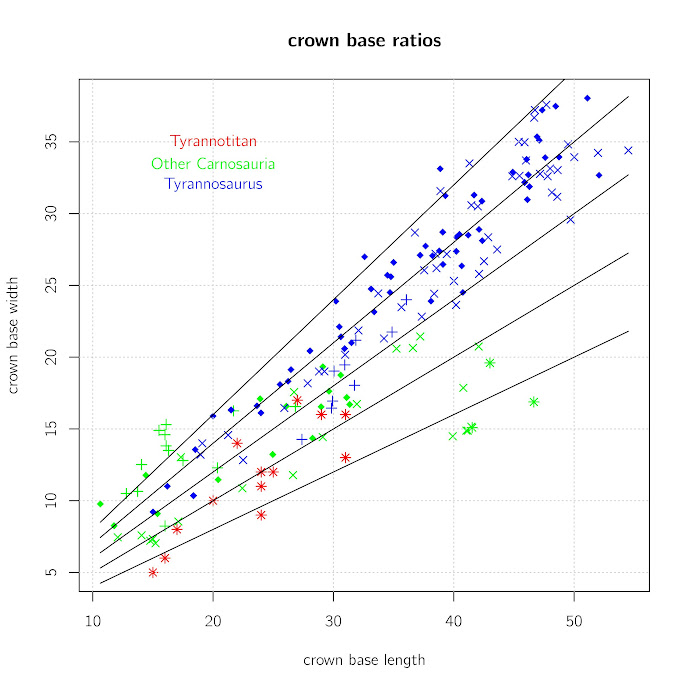
Crown base ratios of Carnosaurs as an indicator of labiolingual compression, with Tyrannosaurus rex as an outgroup. Tooth data from Canale et al. 2015, Royo-Torres et al. 2009 and Smith et al. 2005
Frankly, I have got no idea where this myth originally came from, but being called Tyrannotitan does not imply being in any way more similar to Tyrannosaurus than its relatives were. T. rex does not have a monopoly on that part of its name, on the other hand it seems to have one on its blunt, incrassate teeth.
–––References:
Canale, Juan I.; Novas, Fernando E.; Pol, Diego (2015): Osteology and phylogenetic relationships of Tyrannotitan chubutensis Novas, de Valais, Vickers-Rich and Rich, 2005 (Theropoda: Carcharodontosauridae) from the Lower Cretaceous of Patagonia, Argentina. Historical Biology: An International Journal of Paleobiology, 27 (1), pp. 1-32.
Royo-Torres, R.; Cobos A.; Alcalá, L. (2009): Diente de un gran dinosaurio terópodo (Allosauroidea) de la Formación Villar del Arzobispo (Titónico-Berriasiense) de Riodeva (España). Estudios Geológicos, 65 (1), pp. 91-99.
Smith, Joshua B.; Vann, David R.; Dodson, Peter (2005): Dental Morphology and Variation in Theropod Dinosaurs: Implications for the Taxonomic Identification of Isolated Teeth. The Anatomical Record, 285 (A), pp. 699-736.
---posted 1922, 11/09/2015The Berkeley Tyrannosaurus rex specimen UCMP 118742. Anyone who has made experiences with T. rex fanatics has probably read of this specimen at some point, as evident from a quick google search most likely in the context of someone claiming extreme sizes for it. Why is it so famous? Because it is large, of course. How large exactly? That part of the equation always seems to get misrepresented.
There is only an isolated maxilla, which makes my job both easier and more difficult at the same time. More difficult, because as always when scaling up from a single bone there is quite a bit of uncertainty involved in the final estimate.
Easier because Larson (2008) luckily gave some measurements, and those represent pretty much everything relevant that you can measure in the specimen. So there is virtually nothing left that could suggest a size estimate other than what is indicated by these measurements.
So how do UCMP 118742’s measurements stack up against the size record holder and most complete known tyrannosaur, FMNH PR 2081?
| UCMP 118742 | FMNH PR 2081 | ratio |
| depth | 390 | 400 | 0.975 |
| length | 810 | 855 | 0.947 |
| diagonal length | 690 | 720 | 0.958 |
| tooth row length | 625 | 645 | 0.969 |
Measurements of the Berkeley maxilla and Sue compared.
The obvious implication is that UCMP 118742 is on average just 96.2% the size of Sue, and no more than 97.5% based on the largest measurement. The geometric mean of its maxillary measurements is 607.5, compared to 631.3 for FMNH PR 2081, implying a total length of 11.84m, which is large, but not exceptional. To anyone with an elementary school level of math education this should suggest that Sue, at 12.3m, is the bigger specimen, shouldn’t it?
Messing with growth rates
Well, sadly, this is only the beginning of the argument. Granted, they somehow manage to make it look as if the specimen itself was already larger than sue, which is plain wrong, looking at the fact that every single one of its measurements is actually smaller. But there is an additional bit of information about the individual from which this maxilla came in Table S2 of the Supplement of Erickson et al. 2006: It is apparently 16 years of age. Now, as we know T. rex’ growth slowed down as it matured, until older adults (such as Sue) only experienced negligible growth, and a 16 year old would still be in a phase of fast growth (albeit not a juvenile, as fanboys like to claim), right?
This is Erickson et al.’s growth model for T. rex:
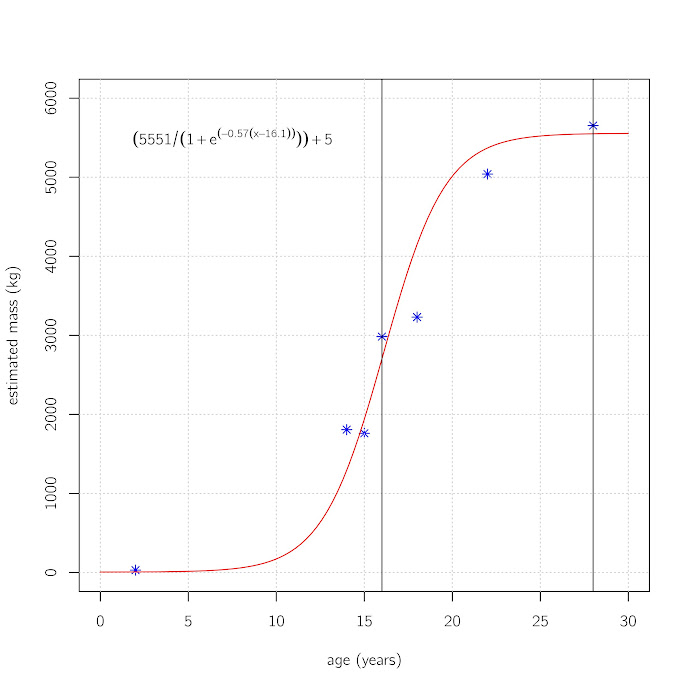
The weight figures are the typical underestimation based on obsolete femur-circumference regressions, but we can use them to compare between each other and estimate total lengths:

Growth curve for Tyrannosaurus rex, modified from Erickson et al. 2004 so that the dependent variable is a length estimate scaled isometrically from FMNH PR 2081 instead of weight estimates.
The first vertical line demarks the age of 16 years, the second that of 28 years, the age of the oldest known Tyrannosaurus.
This is technically what the fanboy claims are based on; the assumption that they can extrapolate the theoretical "fully grown", size of UCMP 118742 based on its actual size and age. That they did so using incorrect and biased premises is hopefully self-evident, but hypothetically, is this a sound method?
The model predicts total lengths of 9.62m and 12.22m at ages of 16 and 28 years respectively. So during this part of its life, the average T. rex is expected to grow 27%, or 2.6m. Applying these to UCMP 118742 results in hypothetical "adult" sizes of 15.05m and 14.45m respectively.
Before you jump to conclusions:
This is not to say that this T. rex would ever have grown that big, and far less even to say that this means T. rex was 14-15m long (it is not, more on that in a future post).
There are several problems with this method. Perhaps the most obvious is sample size. The growth model bases on just a handful of specimens, so the uncertainty involved is very high, and so is the potential impact of adding even a single additional specimen.

Sample of Tyrannosaurus rex length estimates based on femur lengths in Larson (2008) added to data and growth model from Erickson et al. 2004 to demonstrate variability of T. rex sizes with respect to the crowth curve.
Attentive readers might have noticed that UCMP 118742 was not part of the original dataset (not surprising considering the data set bases on femur measurements), and adding it could have a rather significant impact, meaning these estimates are already biased because they exaggerate the difference between the average 16-year old and a fully grown T. rex.
Also, the method assumes that its growth would have continued just as fast as that of any other T. rex (14.45m estimate), or even at an accellerated rate (15.05m estimate). But this was probably not the case, after all, had it grown just like any other T. rex, it would not have been an estimated 11.8m long at the age of 16 in the first place
Many people become oblivious of individual variation as soon as it comes to the tyrant king, but not all specimens of a species grow the same way, and being larger than expected for one’s age during adolescence does not automatically mean being larger later in life (think back to your time at school!). One T. rex might already have been close to full-sized at a given age, while others weren’t.
And indeed, that is what seems to be the case with T. rex specimens that apparently stopped growing at a much earlier age than predicted by this model, around the age of UCMP 118742 to be exact. Horner & Padian (2004) document this in MOR 1125, which they state to have "effectively stopped growing at 16±2 years". This could plausibly apply here too; since the animal had already achieved a large size it could also have grown more slowly from then on. The tyrannosaurine analogue of a human teenager who is very tall at 15, but doesn’t get any larger from then on.
Considering it had already reached a size consistent with those of large adults (e.g. CM 9380), is there any reason to assume this individual would have grown much bigger? Probably not.
And finally, a note to all those people who were eager to see
T. rex as the unchallenged biggest theropod due to just this specimen:
In all probability, similar cases existed among other giant theropods, their ontogeny just hasn’t been studied yet and/or too few specimens have been found so far. This is a single individual, even if it were the abnormal giant of your wildest dreams, it would not have a profound impact on the size of T. rex as a species.
In a nutshell, it is pointless to estimate a hypothetical adult size for such a specimen, and it is dishonest to refer to it as if it were an actual size recorded for the species. We will never know how big it would have grown, but it is most likely that it is just a precocious teenager, big for its age, but not necessarily extraordinarily large had it grown into senescence. and in the end, keep in mind that it didn’t. It is better to stick to real specimens.
–––References:
Larson, Peter (2008): Variation and Sexual Dimorphism in Tyrannosaurus rex. In: Larson, Peter; Carpenter, Kenneth: Tyrannosaurus rex the Tyrant King. Bloomington, pp. 103-128.
Erickson, Gregory M.; Currie, Philip J.; Inouye, Brian D.; Winn, Alice A. (2006): Tyrannosaur Life Tables: An Example of Nonavian Dinosaur Population Biology. Science, 313 (5784), pp. 213-217.
Erickson, Gregory M.; Makovicky, Peter J.; Currie, Philip J.; Norell, Mark A.; Yerby, Scott A.; Brochu, Christopher A. (2004): Gigantism and comparative life-history parameters of tyrannosaurid dinosaurs. Nature, 430 (7001), pp. 772-775.
Horner, John R.; Padian, Kevin (2004): Age and growth dynamics of Tyrannosaurus rex. Proceedings of the Royal Society B, Vol. 271 (1551), pp. 1875-1880.
---posted 1720, 20/08/2015Well first of all, C. subauriculatus is actually the older, and thus valid name, not the inexplicably more popular C. chubutensis (PalaeoDB ONLINE).
This shark species is not nearly as well known, or indeed as common (at least based on ocurrence in museum displays) as its bigger relative, C. megalodon, but it, too, is among the largest chondrichthyans in earth’s history.
The size figure one sees cited commonly is a little over 12m, based on the regression between tooth height and total length in Gottfried et al. (1996) and the largest teeth, which reportedly approach 13cm in diagonal, or slant length.
However, this is fallacious on more than one level, because the method was not supposed to be used with the diagonally measured length, but with vertical tooth height, and because it assumes the same proportions within the dentition as in Great white sharks, which does not appear to be the case.
So, how large was this taxon really?
Purdy et al. 2001 figured, described and listed measurements for two sets of associated teeth, each representing the partial dentition of a single animal.
Better still, the fact that the lateral cusplets (a paedomorphic feature) are absent or very weakly developed is a strong indication that the specimens were adults at the time of death.
The smaller of the two, USNM 411881, has one upper quadrant almost completely preserved. Based on the relative widths of the overlapping teeth, the second one, USNM 299832, is 15.8% bigger.
Completing the dentition by extrapolating the missing anteriormost tooth from the larger specimen (and the diminuitive posteriormost tooth, which is not preserved in either specimen, from C. megalodon), the result is an estimated summed tooth width of ~600m, resulting in a total of ~1200mm in both sides of the upper jaw.
Adding 15% of interdental spacing (admittedly a little liberal), this results in the overall length of the upper toothrow being ~1380mm, that of the larger individual is thus an estimated 1598mm long.
How does this help us?
Much it turns out, since estimating the size of a shark from a complete or nearly complete dentition is much more reliable than using a single tooth.
Lowry et al. 2009 examined the relationship between the length of the tooth row (or bite circumference) and the total length of the shark, and found a strong correlation. Since the best overall analogue in terms of size, ecology and morphology is probably the Great White, the formula relevant here is that for C. carcharias, which we can transform and solve for total length:
LOG(tooth row length)=1.007*LOG(total length)-0.8
LOG(tooth row length)=LOG(10^-0.8*total length^1.007)
tooth row length=10^-0.8*total length^1.007
(tooth row length/10^-0.8)^(1/1.007)=total length

So these specimens were ~8.2 and ~9.5m long, and based on published length-weight-regressions (Casey & Pratt 1985, Kohler et al. 1995) for C. carcharias they probably massed ~5.0-6.0 and ~7.8-9.4t respectively.
But that is not the end of the story. Purdy et al. mention a first lower lateral tooth that is 9.5cm tall, which is 79% and 56% bigger than the equivalent teeth in the aforementioned dentitions, suggesting a tooth-row length of ~2474-2489mm and a total length of 14.5-14.7m.
To put this into perspective, that is well within the territory of C. megalodon, and actually above its average size (which, for adults, is about 14m based on data from Pimiento & Balk 2015).
Obviously every estimate that just bases on a single tooth is prone to huge margins of error, so this should be taken with a grain of salt.
All this shows is that what is popularized about this species’ size is not founded on facts all that firmly.
–––References:
Casey, John G.; Pratt, Harold L. (1985) Distribution of the White Shark, Carcharodon carcharias, in the Western North Atlantic. Memoirs of the Southern California Academy of Sciences, 9 (Biology of the White Shark, a Symposium.) pp. 2-14
Kohler, Nancy E.; Casey, John G.; Turner, Patricia A. (1995): Length-Length and Length-Weight Relationships for 13 Shark Species from the Western North Atlantic. Fishery Bulletin, 93 pp. 412-418
Lowry, Dayv; Castro, Andrey L. F. de; Mara, Kyle; Whitenack, Lisa B.; Delius, Bryan; Burgess, George H.; Motta, Philip: (2009): Determining shark size from forensic analysis of bite damage. Marine Biology, 156 pp. 2483-2492
Pimiento, Catalina; Balk, Meghan A. (2015): Body-size trends of the extinct giant shark Carcharocles megalodon: a deep-time perspective on marine apex predators. Paleobiology, 41 (3) pp. 479-490
Purdy, Robert W.; Schneider, Vincent P.; Applegate, Shelton P.; McLellan, Jack H.; Meyer, Robert L.; Slaughter, Bob H. (2001): The Neogene Sharks, Rays, and Bony Fishes from Lee Creek Mine, Aurora, North Carolina. In: Ray, Clayton E.; Bohaska, David J.: Geology and Paleontology, of the Lee Creek Mine, North Carolina, III. Smithsonian Contributions to Paleobiology, 90 pp. 71-202
PaleoDB: Fossilworks: Carcharodon subauriculatus. http://fossilworks.org/bridge.pl?a=taxonInfo&taxon_no=83172 (accessed 21 July 2015)
---posted on 22/07/2015 at 1911 
Picture of the week: Theropod forelimbs. Besides a few notable exceptions in the technical literature, these are among the more obscure and often-disregarded pieces of theropod anatomy. Nevertheless, they are actually remarkably diverse. Besides the obvious differences between rudiments or near-rudiments and powerful prey-apprehension-tools, even forelimbs with similar anatomy and purpose such as those of Acrocanthosaurus and Allosaurus are still surprisingly variable. Ranges of anteroposterior movement, where available, indicated by curved arrow.
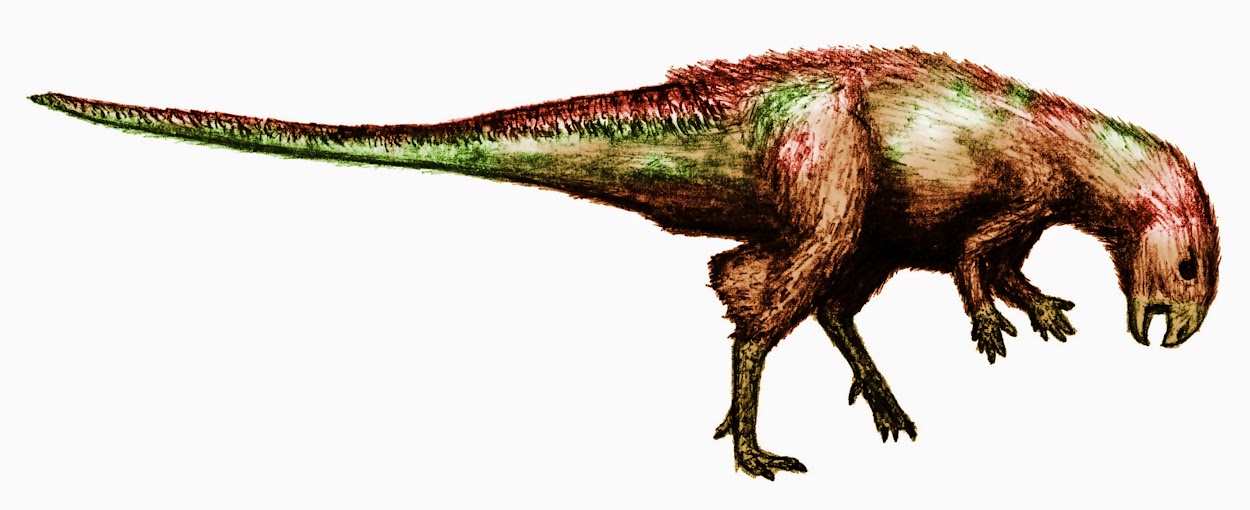
Animal Profile: (Kulindadromeus zabaikalicus: (Godefroit et al. 2014): Not only is it another feathered ornithischian, it also preserved multiple (both simple and more complex) types of filaments along with equally many different types of scales, proving once more how diverse a single archosaurNs integument can be. It is a small Jurassic neoornithischian from (and named after) the Russian Kulinda Locality. On the whole, this animal is clearly further evidence that we should stop thinking of non-avian dinosaurs as big, lizard-like beast, and instead imagine them as superficially similar to birds or even mammals.

Creature of the week: Siats meekerorum was a huge, Cenomanian neovenatorid, only rivaled by Chilantaisaurus tashikouensis in terms of size. Descibed in October 2013 (Zanno & Makovicky 2013), it is the most recent addition to the pantheon of giant theropods. Referred material consists of a partial ilium, some appendicular fragments and several vertebrae, thought to be from one of the biggest predators that ever lived in North America. The size of the ilium points out to an animal significantly larger than Aerosteon riocoloradensis, possibly close to 12m long, which makes it comparable in size to the earlier carcharodontosaurid Acrocanthosaurus atokensis. According to the describers, this specimen wasn’t even fully grown. Together with the also recently discovered tyrannosaurid Lythronax argestes, it helps constrain the time of the allosauroid-tyrannosauroid faunal turnover on the northern hemisphere to an interval of approximately 20ma.
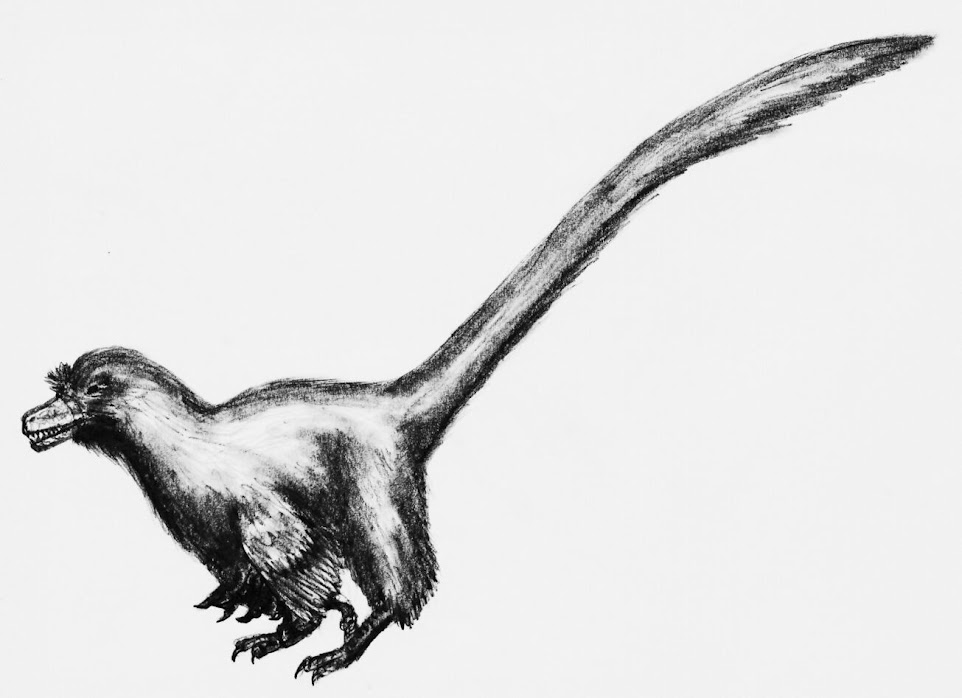
Animal Profile: Pyroraptor olympius is a small velociraptorine dromaeosaur from the Campanian-Maastrichtian boundary of France. It's one of the few well known dromaeosaurs from Europe, even tough the oldest known members of the group were found there. P. olympius shared it's habitat with another dromaeosaurid, Variraptor mechinorum. Similar in size and morphology to the more well known and marginally older Velociraptor, Pyroraptor was likely an agile predator of small and midsized animals, similar to extant accipitrids, that occasionally took larger animals, employing a set of hypertrophied claws, dexterous limbs and flesh-tearing jaws. It's inferrably large brain and the discovery of several associated Deinonychus specimens furthermore suggests it was capable of relatively advanced forms of social behaviour.
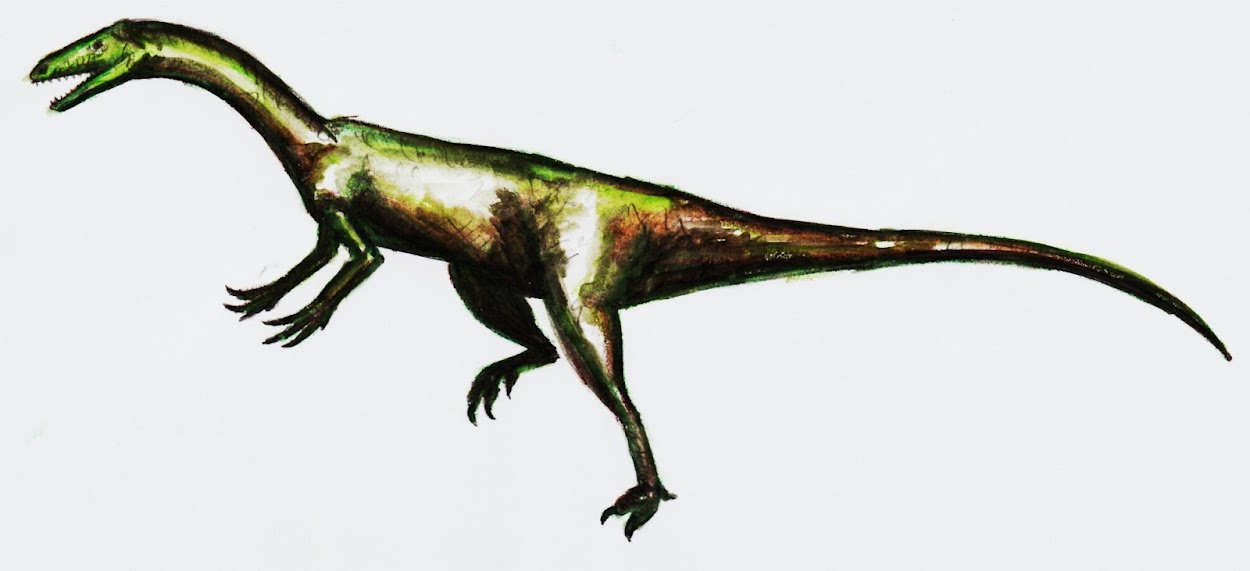
Animal Profile: Coelophysis bauri: This small (~3m and <30kg), basal theropod is in totally unspectacular in most regards, and yet it is among the most popular dinosaurs, and certainly the most well-known Triassic one. Indeed, the special thing about it is that everybody knows it. Perhaps, its because we know it was a cannibal (not that that was overly unusual among dinosaurs), and that there are so many specimens of it.
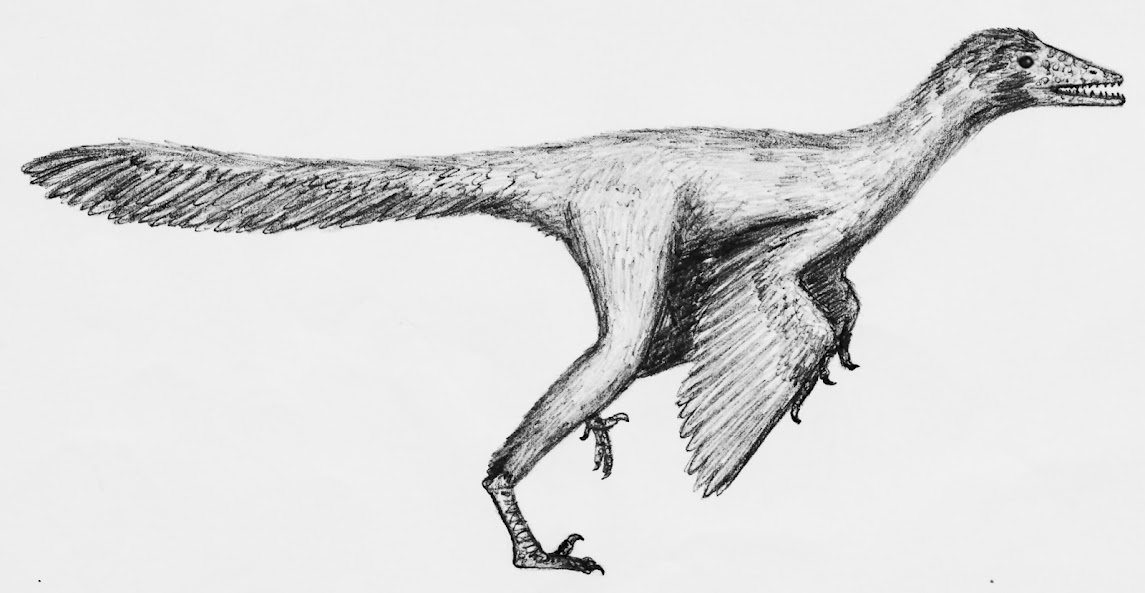
Animal Profile Aurornis xui: Archaeopteryx finally confirmed as the first bird? Possibly! Archaeopteryx dethroned? Nevertheless! A. xui from the Bathonian of China is roughly 10 million years older than the famous "first bird", and referred to a stem-based avialan clade. But the question one inevitably has to ask is; So what are birds actually? Where does a paravian start to be a bird?


Today’s creatures Estimated sizes of some Allosaurid skulls compared; a smallish Allosaurus sp.; the famous Big Al as the lower bound, here compared to the largest A. fragilis; commonly known as Epanterias. The largest known specimens of Saurophaganax maximus, based on a huge humerus and claw, and an enourmous Upper Jurassic ichnotaxon from North Africa that had feet over 80cm long illustrate the potential maximum sizes. Except for the small but complete Big Al, the depicted skulls are extrapolations, but they can give an idea of how large and formidable the largest Jurassic theropods, and the biggest allosauridae, might have been, contrary to popular belief.
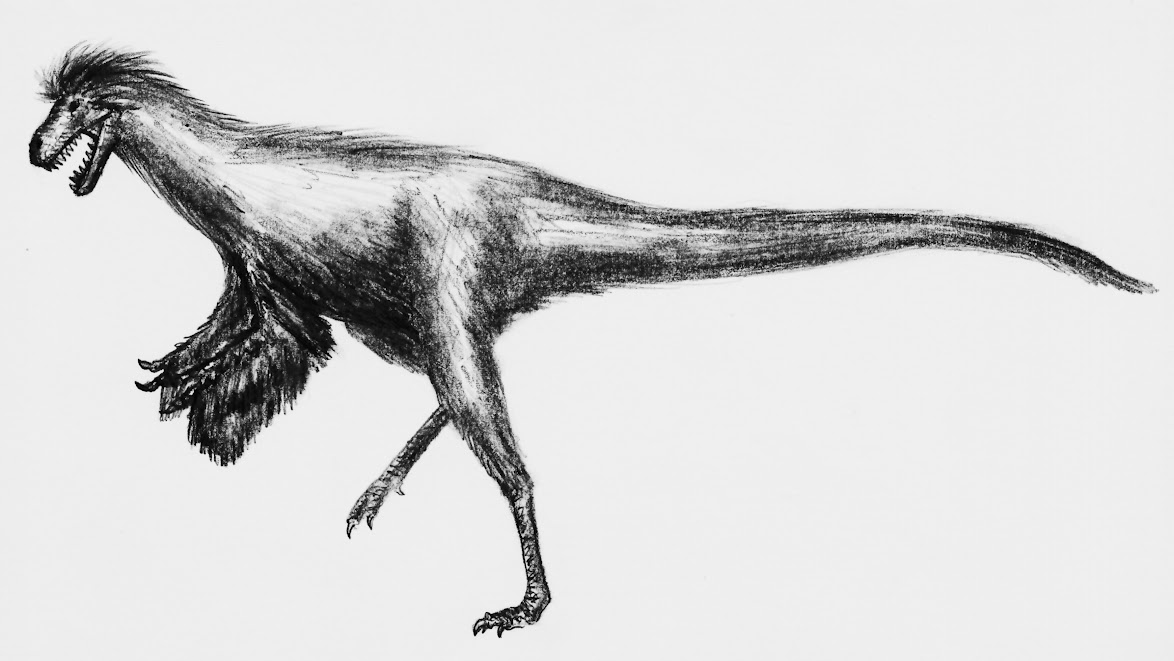
Animal Profile Eotyrannus lengi: Known only from a single incomplete, subadult skeleton from the Barremian of England, this intermediate sized coelurosaur is traditionally placed as an intermediate tyrannosauroid. According to Mortimer, if additional data are added to the analysis, it actually turns out slightly closer to birds than tyrannosaurs. The only resemblence with the later, more popular tyrannosaurines that one can see superficially is in the skull, while the rest of the animal seems that of a typical coelurosaur, with long limbs and elongate, slender built.

Today’s creatures Tyrannosaurus rex skull: FMNH PR 2081, or better "Sue" is and remains one of the largest and most impressive theropods known, measuring a whole 12,3m in axial lenght and probably weighing in at 6-8t, and of those it is definitely the most complete. Despite the name, Sue's gender is totally unknown. The skull of this specimen, despite being badly crushed, is exceptionally well preserved, and very impressive--still the size figures vary quite a bit (from 1,4 to 1,53m) depending on how it is dewarped. The most complete osteology of a theropod that I'm aware of lists the dimension shown in the diagram, but they are mere approximations. It is among the widest, most voluminous tetrapod skulls known, and likely the most massive theropod cranium (by mass or volume)). On the other hand, despite T. rex reputation regarding it's huge skull and bite force, sue does not hold the records for skull depth or lenght; I have shown the major contestants among known theropod specimens in some other pictures. still, this may be the most well known specimen of any dinosaur (at least with the exception of the Berlin Archaeopteryx lithographica), and certainly among the most important ones for our understanding of giant theropods.


Today’s creatures Mapusaurus roseae' and Giganotosaurus carolinii' skulls: Another comparison fo two huge theropod crania: Both are from South America, both are carcharodontosaurs, but Mapusaurus is a few million years younger. Here I've showed both of their largest reported skulls compared. While probably smaller than Giganotosaurus, it is obvious the corresponding animal was far larger than the often-miscited 10,2m. Furthermore, the largest remains attributed to the species are 103-110% those of the Giganotosaurus holotype in linear dimensions, meaning the biggest specimens might have had the longest skull of any theropod, as shown in the phantom outline.


Today’s creatures Carcharodontosaurus saharicus' and Spinosaurus aegyptiacus' skulls: The crania of two of the largest terrestrial predators ever compared; Carcharodontosaurus saharicus was a gigantic carnosaur, likely more than 13m in lenght, Spinosaurus aegyptiacus was a megalosauroid spinosaur conservatively estimated at more than 14m. Both lived in cenomanian Africa and are known from several fragmentary collections. The displayed skulls are the reconstructed cranial remains of the each species' largest specimen, the neotype SGM-DIN 1 (Sereno et al., 1996) of C.saharicus, a nicely preserved skull missing the premaxillae, quadrates, quadratojugals and squamosals, and the specimen MSNM V4047 (Dal Sasso et al., 2005) of S. aegyptiacus, consisting of a rostrum nearly a metre in lenght. The unknown parts where restored after related animals (Acrocanthosaurus atokensis, Irritator challengeri, Suchomimus tenerensis).
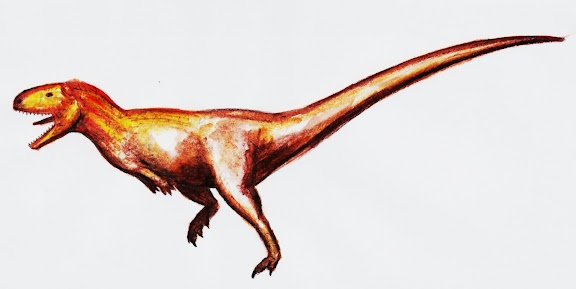
Animal Profile Abelisaurus comahuensis: An impressive abelisaur from the Campanian age of Argentina. These animals probably had some of the strongest bites of all dinosaurs, and Abelisaurus was among the largest, reaching up to 9m long. Like the tyrannosaurus found in the northern hemisphere, they had massive, bulky skulls and tiny arms. This species must have reached weights exceeding 2t.

Animal Profile Zupaysaurus rougieri: Not much is known about this 4-5m long Late Triassic theropod from South America. It was probably related to Dilophosaurus, as can be seen in the gap between praemaxillary and maxilalry teeth. Most reconstructions show it with two crests on the skull, a typical feature of dilophosaurids, which was presumed to be formed by the nasal bones, and not, like in many other theropods, also by the lacimals. A recent analysis has however cast doubt on the presence of a crest, deducing that it could have been formed by lacrimals being dislocated dring fossilisation. The skull measured about 45cm in lenght, suggesting that it was among the rather large Triassic theropods, together with the european Liliensternus liliensterni.
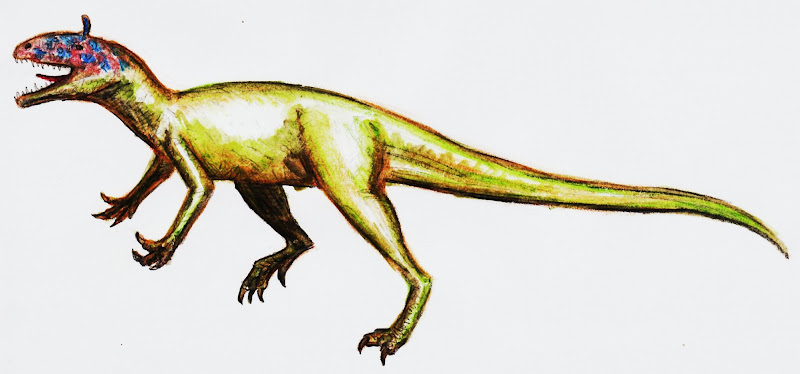
Animal Profile Cryolophosaurus ellioti: C. ellioti is a dubious, Lower Jurassic theropod from the Antarctic. Some consider it a basal tetanuran, being among the first representatives of that lineage, maybe together with the enigmatic Saltriosaurus. Others consider it a dilophosaurian coelophysid. Probably measuring ~7m it represents one of the largest theropods of it's time period. In overall built it was probably a very slender animal, a feature that most likely made it a fast runner. This further confirms the tought of it being a dilophosaur, a group for which such a built is typical and actually found in all members.

Animal Profile Jeholornis prima: This basal avialan from the Jiufotang Formation of Early Cretaceous China is possibly the earliest and most primitive definitive bird known. It shows several primitive characteristics, such as a short, deep skull. J. prima was among the largest Mesozoic birds, reaching nearly 1m in lenght.

Animal Profile Pliosaurus macromerus: This huge predator is probably the largest pliosaur known to science, with an incomplete, referred mandible from the Oxford clay formation measuring almost 3m long. While estimates have varied between 13 and 18m. during its long, complicated taxonomic history it has been known under several different names, including Stretosaurus and even Liopleurodon macromerus

Animal Profile Allosaurus fragilis: It has been known for a long time, it might be one of the most well preserved theropods of all time, the most complete specimen (the sadly undescribed SMA 0005) missing only 11 small bones, and yet it remains mysterious. The holotype is undiagnostic, and no neotype has been designated so far, making the taxonomic mess of several possible species unresolvable. Some allosaurids attained impressive sizes, greatly exceeding the 11m and possibly 12m marks. A well known example of a giant A. fragilis is AMNH 5767, the holotype of "Epanterias amplexus", reaching similar lengths as the more popular T. rex. Compared to the latter its bite is a very different mechanism, the skull having been found to be tremendously strong in the dorsoventral plane, but very narrow and likely not able to produce strong bite forces. Instead, it used a powerful strike-and-slash bite, that made use of the ventroflexive neck muscles to drive its upper dentition into and through the flesh of its prey.

Animal Profile Gargoyleosaurus parkpinorum: an upper jurassic ankylosaur of about 3-4m in lenght, weighing up to 1t. G. parkpinorum is among the earliest ankylosaurs known to science.
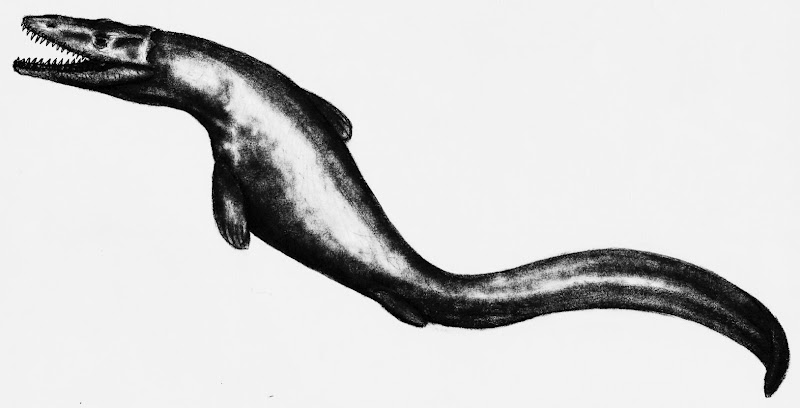
Animal Profile Mosasaurus hoffmanni: at up to 15m in length, it is the largest known mosasaur and one of the largest cretaceous predators. Essentially a huge, snakelike, marine monitor lizard, able to move fast and swallow large prey whole, this mosasaur had no equal in Upper Cretaceous waters.


























